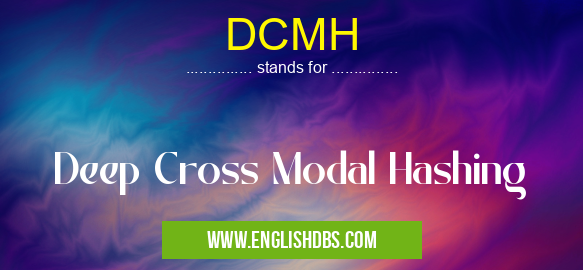What does DCMH mean in UNCLASSIFIED
DCMH (Deep Cross Modal Hashing) is a type of hashing technique that is used to map data from multiple modalities (e.g., images, text, audio) into a common Hamming space. This allows for efficient search and retrieval of data across different modalities.

DCMH meaning in Unclassified in Miscellaneous
DCMH mostly used in an acronym Unclassified in Category Miscellaneous that means Deep Cross Modal Hashing
Shorthand: DCMH,
Full Form: Deep Cross Modal Hashing
For more information of "Deep Cross Modal Hashing", see the section below.
How does DCMH work?
DCMH typically involves the following steps:
- Data Representation: The input data is converted into an intermediate representation that is suitable for cross-modal hashing.
- Feature Extraction: Features are extracted from the intermediate representation to capture the semantic information of the data.
- Hash Function Learning: A hash function is learned to map the features into a Hamming space, where similar data points from different modalities are close to each other.
- Hash Code Generation: The learned hash function is used to generate hash codes for the input data.
Applications of DCMH
DCMH has numerous applications, including:
- Cross-modal retrieval: Searching for data in one modality (e.g., images) using queries from another modality (e.g., text).
- Multi-modal clustering: Grouping data from different modalities into semantically meaningful clusters.
- Data deduplication: Identifying and removing duplicate data across different modalities.
Advantages of DCMH
- Efficient search: Fast and efficient retrieval of data across different modalities.
- Multi-modality support: Ability to handle data from various modalities, such as images, text, and audio.
- Semantic preservation: Preserves the semantic relationships between data points from different modalities.
Essential Questions and Answers on Deep Cross Modal Hashing in "MISCELLANEOUS»UNFILED"
What is Deep Cross Modal Hashing (DCMH)?
DCMH is a hashing technique that efficiently learns cross-modal similarities between different types of data, such as images and text. It leverages deep neural networks to extract features from each modality and then projects them into a common Hamming space, enabling fast and effective cross-modal retrieval.
What are the advantages of using DCMH?
DCMH offers several advantages:
- Efficient cross-modal retrieval: It facilitates efficient search and retrieval across different modalities, supporting tasks like image-to-text retrieval and text-to-image retrieval.
- Compact representation: DCMH compresses high-dimensional data into compact binary codes, reducing storage space and enabling efficient matching.
- Robustness: It is robust to noisy and corrupted data, making it suitable for real-world applications.
How is DCMH implemented?
DCMH consists of three main components:
- Feature extraction: Deep neural networks are used to extract features from each modality.
- Cross-modal interaction: A cross-modal interaction module is employed to capture the relationships between the extracted features.
- Hashing: The cross-modal features are projected into a Hamming space using a hashing function, generating compact binary codes.
What are the applications of DCMH?
DCMH has various applications, including:
- Cross-modal retrieval: Image-to-text retrieval, text-to-image retrieval, and cross-modal similarity search.
- Multimedia indexing: Efficient indexing and retrieval of multimedia content, such as images, videos, and audio.
- Visual question answering: Providing image-based answers to text-based questions.
Final Words: DCMH is a powerful technique for cross-modal hashing that enables efficient search and retrieval of data across different modalities. Its applications span a wide range of areas, including multimedia search, data mining, and information retrieval.
DCMH also stands for: |
|
| All stands for DCMH |
